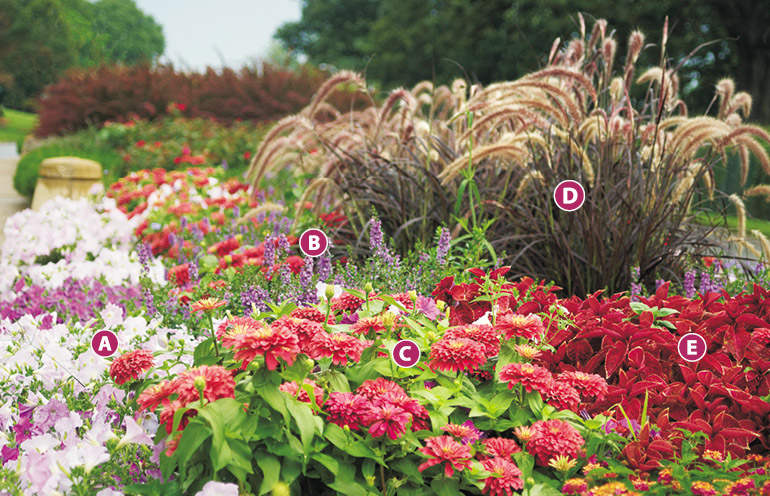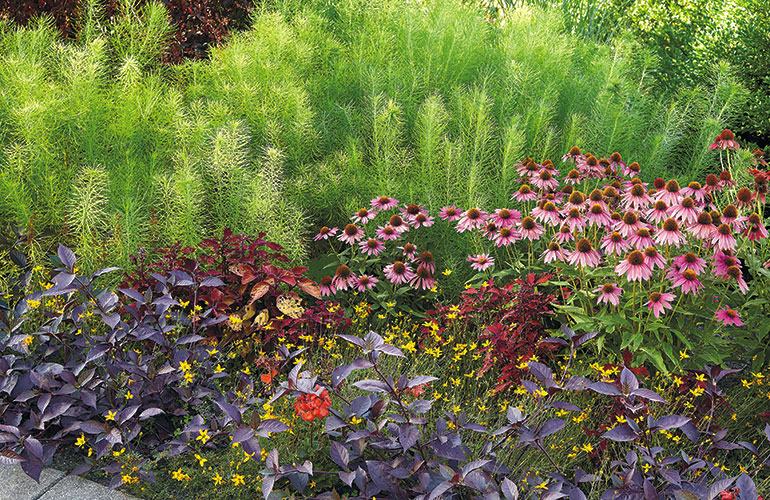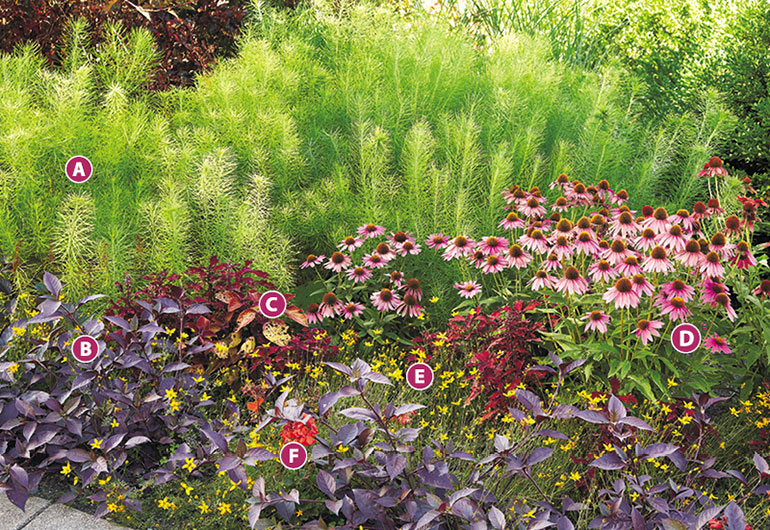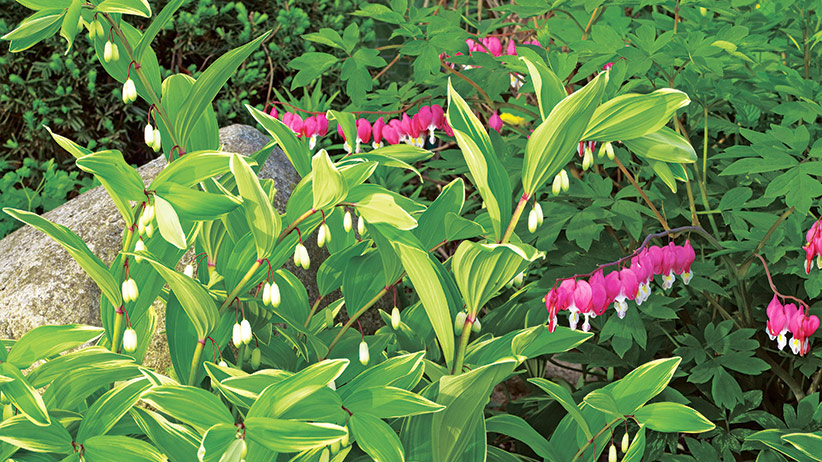
Keep summer colorful
How would you like a summer garden that stops traffic? It’s easy when you grow lots of colorful long-blooming plants. Whether you like soft pastels, vibrant hues, annuals or perennials there are lots of colors and plants to choose from. Start with these basic tips to help you get started then read on and for more details about these full sun plantings.
- When you're shopping for plants be sure to read the tag so you buy ones that like the same growing conditions for sun, soil and moisture that are found in your border.
- Once you get your plants in the ground, water well and give them some time to settle in. Most perennials will take two to four years to get established and really fill out, but annuals and tender perennails will look like a million bucks in just a few weeks.
- First thing in the morning is the best time to water. That way you beat the heat of the day and the water dries on the foliage before night, which helps prevent disease problems.
- Snip off spent flowers to keep plants tidy and possibly get a rebloom.
You Might Also Like:
Colorful Windowbox Plantings
Summer Flowers that Can Take the Heat
Two Stunning Ideas for Your Summer Garden Bed

Colorful summer annuals
There’s no better way to get a sweep of color that lasts than with annuals and tender perennials. Warm weather brings out the best in this heat-tolerant group — plants really take off as temperatures rise. Provide plenty of sun and regular water for best results. It’s OK if the soil dries out a little between waterings but don’t let plants wilt or it will hinder flowering and cause foliage to get crispy.
If you've purchased small plants in multipacks (zinnias are often sold this way) it's a good idea to remove any blooms when you put them in the ground.This encourages more branching and helps plants get a strong root system going. To do this cut stems back an inch or so, making sure there’s still several sets of leaves to provide nutrients for the plant.
Feed and deadhead
A slow-release fertilizer in spring helps feed these plants through the season with little effort from you. For a bloom-busting flower show, you can also apply a water-soluble plant food every 14 days. Start as soon as you see buds on the plants and continue while they’re flowering. Don’t worry about deadheading anything but the angelonia. Magellan zinnia’s new growth covers the old flowers and the petals will eventually fall off. Sun-tolerant ‘Molten Orange’ coleus blooms so late in the season you won’t have to pinch flowers off.
Meet the plants
A) Neptune Mix petunia (Petunia hybrid)
Tender perennial (usually grown as an annual); purple, pink and white flowers from spring to fall; full sun; 10 to 12 in. tall and wide; cold zones 10 to 11, heat zones 12 to 1
B) Archangel® Purple angelonia (Angelonia hybrid)
Tender perennial (usually grown as an annual); purple flowers with a white center from spring to fall; full sun; 12 to 14 in. tall, 10 to 12 in. wide; cold hardy in USDA zones 9 to 11
C) ‘Magellan ™ Coral zinnia (Zinnia elegans)
Annual; coral flowers from spring to fall; full sun; 12 to 14 in. tall, 10 to 12 in. wide
D) ‘Rubrum’ purple fountain grass (Pennisetum setaceum)
Tender perennial (usually grown as an annual); burgundy-tan from spring to fall; full sun; 3 to 5 ft. tall, 2 to 4 ft. wide; cold hardy in USDA zones 9 to 11
E) ‘Molten Orange’ coleus (Plectranthus hybrid)
Tender perennial (usually grown as an annual); orange-red leaves with thin yellow scalloped edge; part sun to part shade; 16 to 24 in. tall, 12 to 15 in. wide; cold hardy in USDA zones 10 to 11
You Might Also Like:
Coneflower Growing Guide
10 Low-Maintenance Perennials for Your Garden
How to Water Perennial Plants

Long blooming summer perennials
While you may head indoors to soak up the AC in summer, fortunately,there are plants that don’t mind this withering weather. In fact, they thrive in it. It’s OK to let the soil dry out between watering for this group, so it's a great choice for an out-of-the-way spot in the yard that’s harder to get to with the hose. A 1- to 2-inch layer of bark mulch can help cut down on watering even more and smothers most weeds. Instead of applying chemical fertilizer, put down an inch of compost in spring every year or so to keep the soil nutrient-rich.
Easy care perennials for summer
Arkansas amsonia is native to the southeastern United States and has steel-blue, star-shaped late-spring flowers. There’s no need to deadhead the blooms — they fall off on their own. Its good looks don’t stop there, though. Once the blooms are gone, its disease free green foliage makes a great backdrop for other plants in the border. And as summer turns to fall, green changes to a gorgeous golden yellow that practically glows.
Powwwow Wild Berry has all the same easy-care attributes of its native cousin, purple coneflower. In addition, it produces loads of 3- to 4-inch rose-purple blooms that hold their color well without fading, as some other varieties do. Remove spent blooms to encourage more or leave them and let the goldfi nches enjoy the big center cones filled with seed.
Get quick color from tender perennials
Tender perennials grown as annuals really hit their stride with the longer days of summer. The rich foliage of ‘Purple Knight’ alternanthera is a great contrast to the yellow-green Arkansas amsonia and bright yellow bidens. If the alternanthera gets too leggy, cut stems back by one third to half for more branching and a bushier habit. Box Office Bronze coleus can take a bit of shade, and still keep its elongated red-orange leaves. Bidens is super heat- and drought-tolerant, and Hawaiian Flare has a taller, more upright habit than other cultivars. Its soft ferny foliage weaves in and out nicely among the broader dark-foliaged alternanthera. While geraniums do slow their flowering when temperatures reach 90 degrees F or more, they’ll perk up again as temperatures cool down.

Meet the plants
A) Arkansas amsonia (Amsonia hubrichtii)
Perennial; steel-blue flowers late spring to early summer, yellow-green foliage turns gold in fall; full sun to part shade; 2 to 3 ft. tall and wide; cold hardy in USDA zones 5 to 8
B) ‘Purple Knight’ alternanthera (Alternanthera dentata)
Tender perennial (usually gorwn as an annual); deep purple foliage all season; full sun; 18 to 36 in. tall, 24 to 36 in. wide; cold hardy in USDA zones 10 to 11
C) Box Office Bronze coleus (Solenostemon hybrid)
Tender perennial (usually grown as an annual); lavender flowers in late summer, red-orange foliage all season; full sun to part shade; 14 to 24 in. tall, 14 to 16 in. wide; cold hardy in USDA zones 10 to 11
D) Powwow® Wild Berry coneflower (Echinacea hybrid)
Perennial; rose-purple flowers from early summer to fall; full sun; 16 to 20 in. tall, 12 to 16 in. wide; cold hardy in USDA zones 4 to 9
E) Hawaiian Flare™ Orange Yellow Blush bidens (Bidens ferulifolia)
Tender perennial (usually grown as an annual); yellow flowers from spring to fall; full sun; 12 to 18 in. tall, 24 to 36 in. wide; cold-hardy in USDA zones 9 to 11
F) Moonlight™ Dark Salmon geranium (Pelargonium hybrid)
Tender perennial (usually grown as an annual); salmon flowers from spring to fall; full sun; 10 to 12 in. tall and wide; cold hardy in USDA zones 10 to 11
















